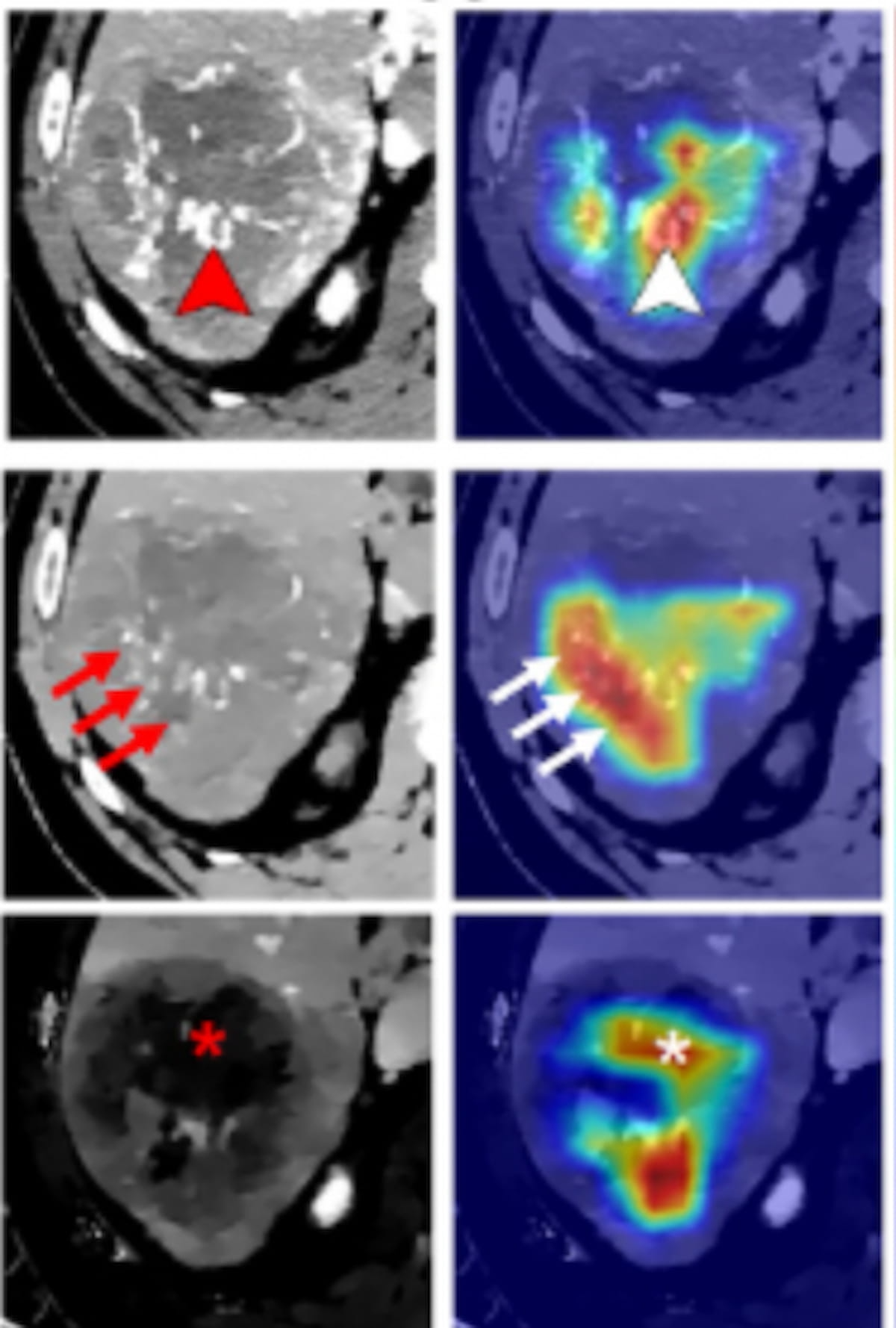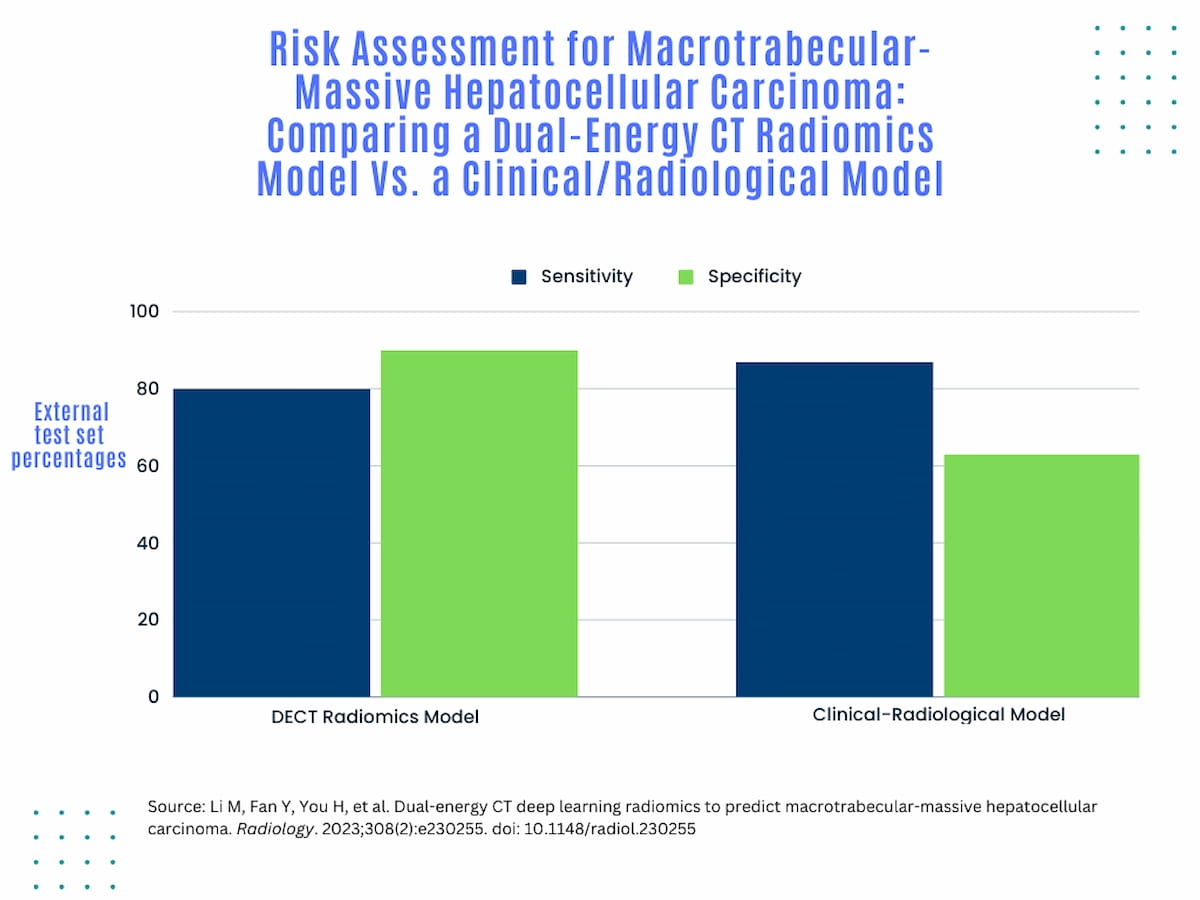Can a CT Radiomics Model Improve Risk Assessment for Macrotrabecular-Massive Hepatocellular Carcinoma?
In comparison to clinical-radiologic assessment, a deep learning CT radiomics nomogram had a 10 percent higher AUC and a 27 percent higher specificity for predicting the macrotrabecular massive subtype of hepatocellular carcinoma in external data testing.
An aggressive phenotype, the macrotrabecular-massive (MTM) subtype of hepatocellular carcinoma (HCC) carries high metastatic risk. While current imaging modalities may reveal independent predictive factors for MTM such as substantial necrosis and severe ischemia, these markers are reportedly plagued by low sensitivity and specificity for MTM.
However, emerging research suggests the use of a dual-energy computed tomography (DECT) radiomics nomogram may significantly improve risk assessment for MTM.
For the retrospective multicenter study, recently published in Radiology, researchers reviewed data from 262 patients with HCC and compared the DECT radiomics model with a clinical-radiologic model, which included factors such as an ⍺-fetoprotein level greater than 100 ng/mL, a platelet count greater than 100 x 109/L, and substantial necrosis.
The researchers found that the DECT radiomics nomogram in comparison to the clinical-radiologic model, had a 14 percent higher area under the receiver operating characteristic curve (AUC) for predicting MTM in the training set of 146 patients (91 percent vs. 77 percent) and a 10 percent higher AUC in the external test set of 81 patients (89 percent vs. 79 percent). While the DECT radiomics nomogram had lower sensitivity than the clinical-radiologic model (80 percent vs. 87 percent in the external data set, it had a 27 percent higher specificity rate (90 percent vs. 63 percent), according to the study authors.
The above imaging is from the case of a 65-year-old man who developed the macrotrabecular-massive (MTM) subtype of hepatocellular carcinoma. The imaging includes arterial phase virtual monoenergetic images (VMIs), electron density maps, portal venous phase iodine density maps and corresponding heat maps. Images courtesy of Radiology.

“In this multicenter study, we found that an ⍺-fetoprotein level of more than 100 ng/mL and deep learning (DL) radiomics models of arterial phase (AP) virtual monoenergetic images, AP electron density, and portal venous phase iodine density were independent predictors for identifying MTM. These four predictors were included in a DL radiomics nomogram model, which showed better performance for predicting MTM HCC in our training, internal test, and external test data sets compared with a clinical-radiologic model … ,” noted Jin Wang, M.D., who is affiliated with the Department of Radiology at the Third Affiliated Hospital of Sun Yat-Sen University in Guangdong, China, and colleagues.
The study authors also pointed out that neither tumor size nor the presence of substantial necrosis affected the performance of the DECT radiomics nomogram.
While the DECT radiomics nomogram had lower sensitivity than the clinical-radiologic model (80 percent vs. 87 percent in the external data set, it had a 27 percent higher specificity rate (90 percent vs. 63 percent), according to the study authors.

Follow-up data for patients in the external data set revealed that patients who were not predicted to develop MTM, based on the DECT radiomics model, had a mean 36-month recurrence-free survival in comparison to a mean of 25 months for those predicted to be positive for MTM.
“The predicted positive MTM groups based on the DL radiomics nomogram had significantly shorter recurrence-free survival than predicted negative MTM groups in our three data sets,” emphasized Wang and colleagues.
(Editor’s note: For related content, see “Microvascular Invasion in Hepatocellular Carcinoma: Can a CT Radiomics Model Have an Impact?,” “Current Perspectives on the BCLC Staging System for Hepatocellular Carcinoma” and “Is Follow-Up Pelvic CT Coverage Necessary for Patients Treated for Hepatocellular Carcinoma?”)
In regard to study limitations, the researchers acknowledged that radiomics features may have been affected by differences in scanning protocols at different centers. They conceded the possibility of statistical bias in a post-hoc subgroup analysis due to unbalanced sample sizes of subgroups. The study authors also emphasized that large multicenter studies are necessary to assess the peritumoral deep learning radiomics model for detecting MTM.
Emerging AI Algorithm Shows Promise for Abbreviated Breast MRI in Multicenter Study
April 25th 2025An artificial intelligence algorithm for dynamic contrast-enhanced breast MRI offered a 93.9 percent AUC for breast cancer detection, and a 92.3 percent sensitivity in BI-RADS 3 cases, according to new research presented at the Society for Breast Imaging (SBI) conference.
Could AI-Powered Abbreviated MRI Reinvent Detection for Structural Abnormalities of the Knee?
April 24th 2025Employing deep learning image reconstruction, parallel imaging and multi-slice acceleration in a sub-five-minute 3T knee MRI, researchers noted 100 percent sensitivity and 99 percent specificity for anterior cruciate ligament (ACL) tears.